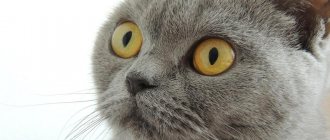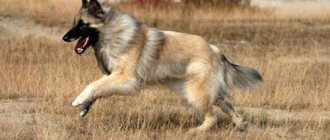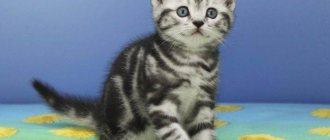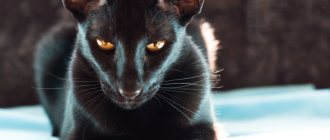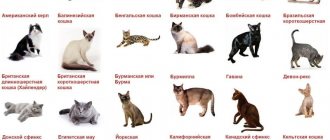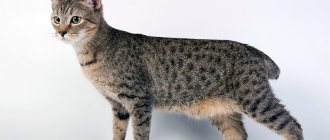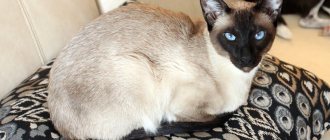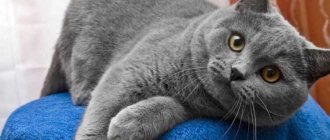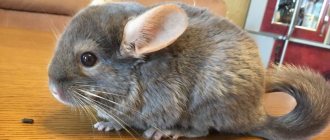History of the origin of the breed
The cat's homeland is Norway, as its name suggests. The Norwegian forest cat appeared quite a long time ago; back in 1599, the Norwegian priest-naturalist Peder Clausson Friis told the world about this furry animal.
There are many legends and myths surrounding the origin of the Norwegian Forest cat breed, told by the peoples of northern Europe. In one of the myths, the chariot with the goddess of love and war Freya was driven by large fluffy cats. Another legend says that the god of thunder and storm lost his powers thanks to the sea serpent Jormugand, who crept up to the god in the guise of a Norwegian cat.
Viking cat is another name for this breed. It is believed that these cats were brought by the Vikings - medieval warrior-robbers. Cats were kept on ships to kill rodents. The name stuck, but the version about the origin of the breed has not yet been confirmed.
In Norway, these cats were considered ordinary, and they lived in forests and on farms. Man took minimal part in the formation of the breed; it developed naturally. Therefore, the Norwegian cat is considered an aboriginal breed. The Norwegian Forest Cat gained its fame (as a breed) only in 1938. At the exhibition held in the city of Oslo, the first cat of this breed, which has a red and white color, was presented.
Officially, the Scandinavian (Norwegian) breed was registered in the FIFE standard in 1977. The national breed standard was adopted a little earlier - in 1973. This breed is the most popular in Scandinavia and is in demand in many other countries.
How to choose a kitten
Like any other purebred cat, the Norwegian Forest should only be purchased from reputable catteries or from trusted breeders. An attempt to save money and buy a pet at the “bird market” or through private advertisements most often ends with you getting an ordinary fluffy “nobleman” or, even worse, a baby with a lot of genetic abnormalities. If you plan to participate in exhibitions, you should carefully check the pedigree of the parents and the compliance of the kitten with the approved breed standard, because minor flaws from the point of view of an amateur can lead to low expert ratings and even disqualification. It is extremely difficult to assess the quality of wool at a young age, so here they focus on the external data of the parents.
The general requirements for a kitten of any class are simple:
- mobility, playfulness and curiosity, which indicate normal development and health;
- a good appetite;
- clean eyes and ears without foreign secretions;
- pink gums;
- absence of skin parasites;
- slightly rapid, but even breathing after physical activity (the opposite indicates problems with the cardiovascular system).
Important indicators are also the living conditions of the mother and kittens - sufficient space for active play, cleanliness, availability of toys, regime and quality of food. Be sure to ensure that the first required vaccination has been completed.
Appearance
Norway's national treasure, the Viking Cat, is distinguished by its strong, muscular body and fluffy, thick coat, ideal for the harsh conditions of Scandinavia. The Norwegian Forest Cat is described in all international standards, each of which has different requirements for the exterior. The main characteristics are similar, but there are a number of differences.
Let's look at how the WCF standard describes the Norwegian breed.
Breed standard according to the WCF system
- Body . Elongated, strong, with massive bones. Sizes – from medium to large.
- Head . In the shape of an equilateral triangle.
- Muzzle . The profile is long and straight, without a stop.
- Ears . Big ones. The base is wide. Located very high on the head. The outer line of the ear runs along the cheeks in a straight line. The ears have a long edge on the inside. There are “lynx” tassels at the tips.
- Chin . Solid.
- Nose . Not described by the standard.
- Eyes . Oval shaped, large and wide open. The color is even and matches the coat color.
- Limbs . Muscular, long. The hind ones are longer than the front ones.
- Paws . Round shape, wide. Between the fingers there are tufts of wool.
- Tail . Very long and fluffy. Must be equal to body length or greater.
- Wool . Double layer. The upper guard hair is long, shiny, hard, and has water-repellent characteristics. The undercoat is thick and fluffy. The guard hair covers only: the back, sides, forelimbs, outer part of the hind limbs and the upper part of the tail. The lower part of the body and the back of the hind legs have only undercoat. On the hind legs there are “breeches.” A triangle-shaped beard hangs from the cheeks.
- Neck . The fur on the neck forms a “jabot”.
- Color . The standard allows any colors and patterns. The exceptions are chocolate, cinnamon (red-brown), lilac and fawn (fawn). Solid coat color should be uniform. The pattern of spots in bicolor and tabby patterns should be clear and distinguishable. Any amount of white is allowed.
- Drawing . All species are allowed: tabby (marble, spot, stripe), tortoiseshell, mackerel, van, harlequin, wild. Color point is prohibited.
- Weight . Females - 3.5 - 5.5 kg, females - 4.5 - 7.5 kg.
- Height at withers . From 30 to 40 cm. Short individuals are considered a disadvantage.
- Lifespan . From 14 to 16 years old.
Important!
Among cats there are long-livers, whose life expectancy is more than 20 years.
Spreading
The family and genus of cats are represented in most countries of Central Europe by only one wild cat (F. catus). In this species, the tail barely reaches half the length of the body, is of equal thickness throughout, is covered with hair evenly throughout, ends bluntly and is 32 centimeters long.
The body length of a forest cat varies between 70 and 90, and the height at the scruff of the neck is between 35-42 centimeters. The fur is brownish-gray, with blackish transverse stripes, the inner thighs and belly are whitish, the crown has black longitudinal stripes, the throat has a yellowish-white spot, the tail has black rings and a black tip. The wild cat is native to Central and Southern Europe, beyond which it spreads not far.
To this day, the cat is occasionally found in the wooded areas of Scotland, Northern and Western England, Ireland, France, Germany, Poland, Hungary, Spain, Italy, Greece, Turkey, the Caucasus and Transcaucasia, where it was found in Georgia.
It prefers to live in vast mountain forests and especially prefers coniferous trees. So, it is still quite common in the Harz and the Alps, but most often in the uninhabited forests of the Carpathians. From these mountain forests, the forest cat descends into the valleys if it finds more or less continuous forest spaces in them, and often moves several days away from its real places of residence.
Colors of Norwegian cats with photos
The colors of Scandinavian cats can have completely different shades and intricate patterns.
Consider popular colors:
Black
Large, beautiful charcoal-colored cats look impressive and respectable. There are pure black animals without a single white hair. But the standard does not prohibit small inclusions of white fibers and white spots.
Red
Red or red-haired Norwegians look very impressive. Shades of red range from bright red to fawn. There may be a white pattern on the body or small patches of white hairs.
White
White fluffy cats look like real beauties. But at exhibitions there are increased demands on such pets - the gene responsible for white color can lead to deafness of the animal.
Tortoiseshell
Tri-colored tortoiseshell cats (and only cats can be tortoiseshells) bring happiness and good luck to their owners. This, of course, is a popular belief that not everyone believes in. But getting yourself such a luxurious beauty is already a great success.
Tabby
The wild color is most associated with this breed. This is exactly what the ancient Viking cats looked like. There are many variations of this color in Norwegian forest cats. These are marbled cats, and tabby, and ticked, and spotted.
Van, harlequin and bicolor
All three colors are similar, differing only in the location and number of colored spots on the cat’s white body. In our country, cats of this color (white and spots) are rare. In Europe, such pets are highly valued. White fluffy dandies with a flowing colored tail look incredibly impressive.
Important!
Only the Norwegian Forest breed has beautiful rare colors of amber (amber) and light amber (lightened amber). These colors are usually called gold or precious.
If furry pets are not your thing, consider the Bengal and Thai cats.
Pros and cons of the breed
Like any other cat breed, the Norwegian Forest has both positive and negative qualities. Reviews from the owners of such animals confirm that positive traits predominate in their character, more than compensating for shortcomings such as excessive shedding.
| pros | Minuses |
| Attractive exterior | Heavily shedding coat |
| Developed hunting instinct | Excessive activity |
| Cleanliness |
Norwegian Forest cats are large and very active cats, suitable for both urban and rural life. Representatives of the breed are very attached to their owners and do not cause much trouble.
Care and maintenance
To get yourself a big, fluffy, handsome cat, you need to prepare and study the features of keeping it at home. It is also important to calculate your strength and estimate the budget that will be required to care for such a pet.
Content Features
The first thing Norwegian Forest cats need is space. Yes, this breed is owned by city apartment owners, but it is better that it is not a small one-room apartment. Cats are large, active, athletic, and need room to climb. In a large private house, Norwegian forest cats feel more at ease.
In addition, representatives of this breed love to walk in the fresh air. Fresh air is good for appetite and coat. They can be walked on a leash or released into the yard of your home if you are sure that it is safe there. Norwegians are excellent hunters - don’t be surprised if your pet starts bringing you prey from a walk. Moreover, it can be not only mice and birds. Norwegians are not afraid of water, they know how to fish. Some owners build spacious enclosures in their yards for their pets.
In Europe, adult cats are sometimes kept in enclosures that contain insulated enclosed houses. But, only adult (most often elderly) cats who previously lived with people in the house. Constantly keeping an enclosure from an early age will lead to the animal going wild.
Cats of this breed love and know how to climb vertical surfaces. This is the only breed that nature has taught to descend from trees in a spiral (like a squirrel) upside down. If you have a special tree at home (a vertical play structure up to the ceiling), cats will climb it. If there is no tree, they will climb doors and cabinets. They do it very cleverly.
Grooming
The luxurious wool of the Norwegian is the main advantage of the cat and the subject of care and attention for the owner. The peculiarity of the breed is semi-long, waterproof guard hair and a dense, thick undercoat. To keep the house clean and your pet’s coat in good shape, you need to comb the pet’s fur at least twice a week. This is done first with a sparse comb with non-sharp teeth, and then with a brush with natural bristles.
Your pet's coat requires special care in the spring, when seasonal shedding begins. Before the onset of the warm season, Norwegian forest cats completely shed their undercoat. All summer they walk around looking different from the furry pets they were in the winter. In autumn, a new undercoat grows, the coat becomes longer and thicker. At this time, the owners will have to comb the cat daily, and it is best to use a furminator.
There is no need to bathe cats unless absolutely necessary. This is difficult to do, since Norwegian wool is waterproof. If the animal is heavily soiled, it is best to try to wash only the areas of contamination. The exception is for show class pets - they are bathed with special grooming products before shows and competitions.
Dental care
To prevent periodontal pathologies, the cat’s teeth and oral cavity are cleaned with a special brush and veterinary toothpaste at least once a week. Only a doctor in a clinic should remove tartar. In order to promptly detect hard deposits on teeth, it is necessary to regularly undergo preventive examinations with your pet in the clinic.
Eye care
The pet's large eyes are examined daily and wiped with a damp cotton pad to clear any discharge. A different disk is used for each eye. If the discharge from the eyes is colored, foul-smelling discharge is a reason to immediately contact a veterinarian.
Nail care
The animal has long claws. If a cat leads an active lifestyle, climbs a lot, uses a scratching post, and walks, then the claws will wear down naturally. If the claws are not worn down enough, they are trimmed with special veterinary scissors. This is done carefully when the animal is relaxed. It is not recommended to hold a resisting pet by force - this causes psychological trauma to the animal.
Ear care
Large cat ears do not require much care. They need to be examined weekly, and if necessary, wipe the auricle with a damp swab. Do not use cotton swabs for ear care - this can injure the inside of the ear.
Castration and sterilization
Owners of Norwegian cats may not want offspring at all. But if an unsterilized cat never gives birth, this can lead to female diseases (including uterine cancer). Cats are neutered (if kittens are not wanted) for the reason that they mark territory. For castration and sterilization, you can contact any veterinary clinic. During the operation, the gonads are removed, after which reproductive function stops and the amount of sex hormones produced decreases. Sometimes such operations are performed for medical reasons. Now such operations are often practiced, so this procedure is relatively inexpensive (from 1000 rubles).
if you do not want kittens, it is recommended to sterilize the cat
The operation is inexpensive and the problem is solved once and for all. Cats feel great after anesthesia, don’t worry, it’s much more humane than she is now suffering and tormenting you. I sterilized mine, so the first thing she did after the operation was eat.
OLGA Alex, forum visitor
https://www.e1.ru/talk/forum/read.php?f=130&i=297710&t=297710&
At what age is it recommended to do it?
Veterinarians still argue about when to spay/neuter a pet. But experts agreed on one thing: by the time of the operation, the animal’s internal organs should already be formed. Cats can be operated on from about 8 months, males - from 9 months. The ideal age for surgery is considered to be the period of time between the formation of internal organs (8–9 months) and the first mating.
I sterilized my old cat when she was not even a year old. In the first spring before this, she suffered terribly, rolling on the floor and meowing heart-rendingly. On the advice of the veterinarian, I bought drops, but they did not help. After a few more days, I finally decided to have the operation. The fact is that I don’t need kittens, and all my cats have always been “chosen,” but sterilization seemed to me an inhumane undertaking. And now I understand that it is better to endure a week of walking in a blanket and a slight weight gain, just so that the cat no longer suffers and does not ask to be seen by a cat.
After surgery to remove the gonads, the cat needs proper care
When an old cat is castrated, the animal's body can behave unpredictably. To avoid complications after recovery from anesthesia, you need to make sure in advance that the operation is necessary. An experienced veterinarian will help here (conduct the necessary tests, etc.). In any case, the operation itself takes place quite quickly (10–15 minutes), and the owner can expect the doctor’s comment right in the clinic corridor.
Caring for your pet after surgery
When you take your pet home, he will still be lethargic and sleepy, and saliva may be leaking from his mouth. During this period, you need to show the animal that it is safe. Due to a lack of understanding of what is happening, a cat can climb into a hard-to-reach place or climb to a height. And in a comatose state this is extremely undesirable (the cat may fall and harm itself). While recovering from anesthesia, the animal may sleep a lot. Try not to leave your pet alone.
After a day or two, the cat will try to free itself from the blanket. As the stitches heal, they may itch, and the animal will want to lick the itchy area, but this should not be allowed. Periodically you need to inspect the knots of the protective clothing (if they are loose, tie them tighter). You need to tie it carefully (do not pinch the animal’s skin or crush the belly). On the day appointed by the veterinarian, you will need to come to the veterinary clinic again. Your cat's doctor will remove the stitches, examine your cat again, and make recommendations for further care.
After castration/sterilization you need to follow a cat diet
Castrated and sterilized animals tend to become overweight (as the whole body undergoes restructuring). Therefore, you need to review your pet's diet and make sure that its food is balanced. In addition, the operation does not exclude the possibility of developing urolithiasis, so you need to reduce the amount of foods containing calcium, phosphorus and magnesium. You also need to make sure that the cat always has access to clean water (it should drink a lot).
How much money do you need for care and maintenance?
When purchasing a purebred pet, you need to evaluate your financial capabilities and know how much it will cost to buy a kitten, accessories for its maintenance and how much you need for monthly quality care.
What to buy for a kitten
Required set:
- Two or three bowls (2 – natural food, 3 – ready-made food). Choose a large bowl for water - Norwegians like to splash water with their paws. Ceramic or metal ones on a stand are best. Price: 380 – 1300 rub.
- Tray. Large with deep sides. Large cats should have room in it. Price: 2700 – 1300 rub.
- Wide-toothed comb and brush with natural bristles: RUB 340 – 600.
- Scratching post. Vertical, wall-mounted for large cats: 900 – 3500 rub.
- Toys. Intellectual pointers, balls, and laser pointers are suitable. Price: 700 – 3000 rub.
- Bed. Large, suitable for dogs: 800 – 1900 rub.
Additional products:
- Plastic carrier with metal door. It is best to take models for dogs. Price: 2500 – 8000 rub.
- Stable vertical play set with weights and sisal scratching posts. Price: 10,000 – 15,000 rub.
- Claw cutter. Price: 350 – 500 rub.
- Harness with leash. Price: 850 – 1500 rub.
- Anti-cat bars for windows. Price: 1800 – 2500 rub.
- Furminator for long-haired cat breeds. Price: 1200 – 2400 rub.
Annual care for a Norwegian forest cat may require from 20 to 60 thousand rubles.
The budget will depend on your capabilities, the chosen diet, the type of filler, and the frequency of treatment and preventive measures.
Feeding pets of this breed is not difficult, but you need to take into account that their coat requires good nutrition: complete, balanced and fortified.
Health and illness
The Norwegian Forest breed is indigenous, that is, it was created naturally under the influence of harsh external conditions. Human intervention in the creation of this breed is minimal. Cats are muscular, strong, and easily adapt to cold and wet climates. But, like all breeds, they are prone to certain diseases.
Genetic pathologies of the breed
- Glycogenosis type IV. The disease is rare, detected only in Norwegian cats. With this pathology, glucose metabolism in the animal’s body is disrupted. Kittens are stillborn and die within the first hours after birth. In some cases, signs of the disease appear only at the age of 5-8 months. The disease is fatal and has no cure. Detected by the results of genetic tests.
- Hypertrophic cardiomyopathy. Hereditary heart disease is common in large cat breeds (such as the Maine Coon). Can be detected by DNA tests.
- Hip dysplasia. Pathology of joint development leads to discomfort, pain and lameness. Detected by hip x-ray.
- Polycystic kidney disease, a hereditary pathology that gradually destroys the kidneys. Detected by ultrasound at 10 months of age. DNA tests are not available for this disease.
To protect yourself from these serious hereditary pathologies, it is necessary to ask sellers and breeders for the results of tests and examinations of the kitten and its parents.
Treatment and preventive measures
In order for your pet to live a full, healthy life, you must not neglect preventive measures:
- vaccination according to the vaccination schedule and compliance with quarantine measures;
- antiparasitic treatment for external parasites (at least 2-3 times a year);
- anthelmintic measures (2-3 times a year);
- ensuring a high-quality balanced diet;
- vitaminization.
Annually, treatment and preventive measures may require from 4,000 to 6,000 rubles.
Important!
If you do not plan to become a breeder of a Norwegian forest cat, in the first year of a kitten’s life, budget for the cost of sterilization (castration) surgery - 1500 - 4000 rubles.
Features of hunting
A forest cat attacks a person only in extreme cases or when wounded.
The forest cat feeds on warm-blooded animals: calves of wild goats, young chamois, hares, rabbits, rats, mice and other rodents, as well as various birds.
The forest cat tracks its prey not so much by smell as by sight and hearing. In May or April, the female lays six blind cubs, placing them in a hollow, a rock crevice or some other secluded corner; in case of danger, she drags them to another, more reliable place.
In its behavior, the forest cat is very reminiscent of a domestic cat, just like the latter, it purrs in a good mood, opens its mouth in anger, arches its back and expresses its feelings by moving the tip of its tail.
In many, if not all, localities of the region of its distribution, the forest cat has become so mixed with the feral domestic cat that it becomes doubtful whether it is still preserved anywhere in its original purity.
According to some researchers, the forest cat generally evolved from the wild domestic cat, but this view is unlikely to have any basis.
Feeding
Each owner chooses the type of food (natural or prepared food) himself. Some owners stick to the diet that the breeder fed the kittens. If you are in doubt when choosing the type of food, it is best to consult a veterinarian or professional Norwegian Forest Cat breeders.
Natural nutrition
The Norwegian cat appeared naturally - it is a real predator from the forests of Scandinavia. Predators eat meat. In the case of the Norwegian breed, it is also a fish. These cats are excellent fishermen.
Therefore, the basis of the diet (70%) should be meat, meat products and fish. The rest is vegetables, herbs, dairy products.
- Dietary meats: rabbit, veal, turkey, chicken.
- By-products: lung, liver, heart.
- Fish: low-fat sea varieties. Give once a week in boiled form.
- Vegetables: zucchini, carrots, pumpkin, broccoli, beets.
- Low-fat fermented milk products: cottage cheese, fermented baked milk, kefir.
- Natural yogurt.
- Eggs. Quail or chicken yolk.
- Greens: spinach, lettuce, sprouted oats.
- Bran.
- Yeast.
- Vitamin and mineral complex according to age and health status.
Meat and meat by-products are given raw. To get rid of possible parasites and bacteria, meat products are frozen for 2-3 days. Thaw at room temperature before serving to the cat. There is no need to mince the meat - the meat is cut into pieces. The cat must have stress on its gums and teeth.
List of prohibited products:
- legumes;
- exotic vegetables and fruits;
- potato;
- corn;
- whole milk;
- fat sour cream and cream;
- pork;
- kidneys;
- sausages and sausages;
- smoked meats and canned food.
With this type of nutrition, the feeding rate is calculated using the formula: daily rate = 7% of the cat’s weight. Adult pets need only two meals a day.
A monthly natural diet will require 1,500 to 3,500 rubles.
Industrial feed
The main requirement for industrial feed is balance and nutritional value. Economy class food should be abandoned initially - it contains few nutrients, but a lot of dyes, flavor enhancers and artificial flavors and preservatives.
The choice should be made in favor of quality brands of at least “super-premium” class.
The pet industry produces ready-made food specifically for this breed, but any brand for large cats will do.
Recommended brands of food:
- Orijen Cat Fit & Trim Grain Free – a grain-free brand for pets prone to gaining excess weight;
- Acana Regionals Pacifica Cat Grain-Free – Grain-free, fish-based formula for cats and kittens;
- Carnilove Adult Cat Large Breed Duck & Turkey Grain-Free – with duck and turkey for large cats;
- Brit Care Tobby I'm a Large Cat - Duck & Chicken Grain-Free Hypoallergenic - hypoallergenic formula for adult large pets;
- Royal Canin Norwegian Forest Cat is a super-premium food for the Norwegian Forest cat breed.
On average, Norwegian cats need 50-120 grams. dry food per day. The individual rate is calculated depending on the weight, age, activity and condition of the pet.
Monthly feeding with ready-made food will require 1000 to 3800 rubles.
Important!
Norwegians are large cats with a good appetite. Throughout their lives, it is necessary to control their weight and prevent overfeeding and obesity.
FAQ
How many live at home?
With good care and nutrition, healthy representatives of the Norwegian breed live a long time. On average - 14-16 years. They can live more than 20 years; such cases have been recorded in the history of this breed.
What is the weight of an adult and a kitten?
Norwegian cats are larger than cats. At six months they can weigh 3-4 kg, by two years 7-8 kg. Kittens at 6 months weigh about 1.5 kg, at two years they reach a weight of 4-5.5 kg.
Is it easy to hold?
The cat is not tame. Norwegians value their own and their personal space.
They do not like to sit on their laps, preferring to be close to them, curled up in a ball. They don't like to be kissed, but they love to be stroked and scratched. As a sign of love and appreciation, they can “butt” a person’s forehead or legs.
Can I keep it outside?
We have already written that in Europe cats are kept in cages in nurseries. But this applies only to adults who have lived and been raised in a family since childhood. Kittens cannot be placed in enclosures. Yes, cats can withstand the harsh conditions of the street, but they run wild there. An aviary is needed for walking this breed. Fresh air has a beneficial effect on the quality of their luxurious coat and improves their appetite.
How aggressive is the breed?
Norwegian Forest is absolutely not aggressive. Representatives of this breed do not show aggression towards children, other pets, or strangers. They are calm and balanced. They don’t divide the territory, they don’t start wars. Behind the stern appearance hides a gentle, good-natured animal.
Do they like to claw/climb?
The forest cat's favorite pastime is climbing trees. This is what the Norwegian forest dog does with pleasure. There are no heights that are inaccessible to them. Cats deftly climb vertical walls, doors, and cabinet doors. What is surprising is their ability to descend upside down - they do it without panic, quickly and easily. Cats are smart, so it won’t be difficult to train them to scratch their claws on a scratching post.
Is this breed hypoallergenic?
The breed is not hypoallergenic. The fur of a Norwegian cat can cause allergies.
Do you need to take care of your fur?
The Norwegian's double coat requires regular grooming. Under normal conditions, it is enough to brush your cat 1-2 times a week. During the molting period, they do this daily and use a furminator.
What color are eyes?
Almost anyone. A golden-green shade is preferable, but copper, gold, and green can also be used. White cats have blue eyes.
Is the breed prone to heart disease?
Unfortunately, nature did not spare these large, strong cats. They live easily in harsh conditions, but can inherit heart disease such as hypertrophic cardiomyopathy.
At what age do they stop growing?
Like all native breeds, Norwegian cats develop slowly and mature late. They reach full maturity by 4-5 years, while they retain the temperament of a kitten almost all their lives.
Purchasing a kitten
As a rule, wild cat kittens are born healthy and strong. They become covered with outer coat at the age of three months, but become fully grown by the age of five. Buying a Nordic kitten is difficult. There are many advertisements on the Internet and newspapers about the sale (or gift) of these babies, but it is almost impossible to verify the purebredness of their breed. But if you need a kitten for yourself (for the soul), then you can resort to advertisements. But if purebredness is extremely important (for example, for breeding), then it is better to contact either professional breeders (and there are few of them) or a nursery. The fact is that nursery employees and volunteers are not interested in deception, so the risk of being deceived is minimal.
Norwegian kittens are very similar to their parents (they can be identified by the shape of their eyes and the length of their paws)
Such a kitten can cost up to 25,000 rubles. The price depends on several factors:
- purity of the breed (with pedigree is more expensive);
- coat color;
- city (large cities are more expensive);
- prestige of the nursery.
If a kitten is bought second-hand, then the price can range from 1000 rubles and more.
Criterias of choice
When choosing a Norwegian baby, you need to pay special attention to the following criteria:
- age;
- health;
- behavior;
- pedigree;
- health of the nurse cat.
It is advisable to adopt a kitten at the age of three months. First, you need to wait until the cat has taught her baby everything (use the litter box, eat, play, etc.). In addition, primary immunity is instilled in the baby with the cat's milk. The exception is if the kitten has lost its mother, and feeding her with milk is already impossible. And secondly, up to three months the kitten is vaccinated. If the baby is of suitable age, you need to examine the animal. He must be active, clean, without any damage to the coat or skin. Some are guided by the rule “the kitten chooses its owner.” If a cat rushes into your arms, this may be just such a case. Pay attention to the documents. A purebred Norwegian must have a pedigree. The more ancestors of a cat are known, the better. Finally, examine the cat. A healthy cat has a healthy kitten. Naturally, you can make a discount on feeding. Mommy may be a little lethargic and her coat may be slightly dull.
Reviews from Norwegian Forest Cat owners
Irina : “My Nafanya is a little Norwegian miracle! He never let out his claws. I never, ever walked past the stall. Always nearby, but does not try to beg for attention. Loves to sit next to me when my husband and I watch TV. Right next to us so that we can see - here I am! When guests arrive, he first peeks around the corner, gets used to it and takes a closer look. If he is noticed and called, he runs happily and can play with the guest. The coolest thing is that he knows how to feel sorry. I’m going to cry, Nafanya immediately comes running and licks away the tears, calming me down. I don't want to cry right away. He never yells. Even if we forget to give him food. He can sit silently and sadly near the bowl for hours. This is so touching".
Denis : “My cat is already 9 years old. But he doesn't give the impression of being an "old man." They say that Norwegians take a long time to grow up and do not age for a long time. He replaces my dog. He waits for me from work, meets me at the door, sleeps nose to nose. He can answer me in cat language if I tell him something. What else? He brings a ball and a mouse, just like dogs do. I walk him on a leash every day. Frosts are not scary for him, he even loves this weather. We go out all year round. In winter, he is drawn to the window frame - it’s cooler there. Can lick ice off glass like moose lick salt.”
Raisa Petrovna : “I have had many different cats throughout my life, but this is the first time. When a neighbor’s dog chased Marquise up a tree in the courtyard of the dacha, I got scared and went to look for a ladder. Imagine my surprise when I saw a cat on the ground. Then she herself climbed the apple tree several times. I saw her getting down. From the outside it looked like a huge squirrel with a fluffy long tail. She deftly moved her paws and moved upside down. No other cat in the world can do this.”
Video reviews:
Character
Despite their independent and freedom-loving nature, “Norwegians” are attached to people and feel the need to communicate with people. An inquisitive animal can disappear on the street all day, not respond to the owner’s call, and return home when it wants. Adapts well to new conditions.
The character contains:
- canine loyalty, devotion and patience that a cat shows if they do not run counter to his personal plans;
- stubbornness - will not do anything against his wishes, does not give in to persuasion;
- lack of sentimentality - does not like to be “squeezed”, stroked, hugged, purrs with pleasure next to the owner if he is not touched;
- resentment - will not forgive the owner for a long absence;
- friendliness, sociability - finds contact with animals, with all family members, with strangers;
- caring, love for children - flirts with children, happily amuses them, does not release his claws, does not bite children;
- dignity - will never annoy the owner, demanding attention, will find something to do with himself;
- hospitality - greets guests at the entrance, allowing themselves to be stroked;
- fearlessness, self-confidence - it can be seen at the highest points of buildings;
- sense of proportion – increased activity alternates with Nordic temperament, balanced.
The animal is tactful, delicate, not annoying, and senses the mood of the owner. He knows when to come up and purr in his ear, and when to sit quietly away.
Kittens mature late, character traits are formed at 4-5 years. Therefore, you should not be surprised when a large, massive cat plays with a bow on a string or chases a glare of the sun. Until the age of 5, he feels like a child and body size does not affect this.
Being on the courtyard territory, he fearlessly explores the space and enjoys spending time in the fresh air. He likes to climb to the very top of trees, sit for a long time on thin branches, watching from above what is happening.
Females have a prouder and more independent character than males. Cats of this breed are more affectionate and gentle than cats.
How much does a Norwegian Forest cat kitten cost?
The price tag for Norwegian Forest cat kittens has a wide range - from 12,000 to 90,000 rubles. (4,000 – 35,000 thousand UAH).
What does the price depend on?
The price of a kitten depends on:
- Pedigree and titles of parents.
- The breeder's expenses for maintaining a kitten, organizing an exhibition career for producers.
- Breed characteristics (belonging to a certain class).
- Sales with and without breeding rights.
- Rarities of color.
About 80-85% of the cost depends on the class:
- SHOW (show) – the highest class. The kittens fully comply with the breed standard. Used only for breeding and exhibition activities. Price: from 65,000 to 90,000 rubles;
- BREED - healthy kittens without genetic pathologies and good characteristics, with a slight discrepancy with the breed standard. They can participate in exhibitions and shows. They cost from 30,000 to 50,000 rubles.
- PET (pet) - purebred kittens with minor deviations from the standard or minor defects are not allowed for breeding and exhibitions. Price: from 12,000 to 25,000 rubles.
Where to buy a Norwegian Forest kitten
There are breeders and nurseries in all major cities of Russia and Ukraine.
In Russia
- Nursery “IXTLAN”, Moscow – https://move-ixtlan.ru/;
- “NORTH CAPE*RU”, St. Petersburg – https://northcape.ru/.
In Ukraine
- There are no nurseries
Those who want to buy cheaper can purchase a kitten through bulletin boards on the Internet. They offer the offspring of Norwegian forest cats for 3,000 – 5,000 rubles. (1,500 – 2,100 UAH). However, do not expect that for that kind of money they will sell you a purebred, healthy kitten with good characteristics.
